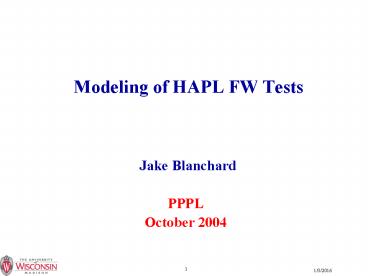Modeling of HAPL FW Tests - PowerPoint PPT Presentation
1 / 19
Title:
Modeling of HAPL FW Tests
Description:
1. Modeling of HAPL FW Tests. Jake Blanchard. PPPL. October 2004. 11/4 ... for 1 MPa pressure is 1.8 MPa and less than 1 MPa at the tungsten to steel interface ... – PowerPoint PPT presentation
Number of Views:15
Avg rating:3.0/5.0
Title: Modeling of HAPL FW Tests
1
Modeling of HAPL FW Tests
- Jake Blanchard
- PPPL
- October 2004
2
Outline
- Fracture Modeling for Surface Tests (short pulse
XAPPER, RHEPP, Z, Dragonfire - Flat Specimens in IR facility
- Cooled Specimens in IR facility
3
Purpose of Modeling
- Goal Ensure wall survival
- Tests will help us determine design limits of
tungsten-coated steel walls - Modeling is required to help us understand
failure mechanisms - Hypothesis is that damage is thermomechanical
- Combination of tests and modeling will help with
design - Previous analyses predicted cracking at tungsten
surface
4
Fracture Model
5
Typical Behavior in HAPL Chamber
Stresses at Maximum Temperature
Stresses After Cool Down
MPa
MPa
6
Fracture Mechanics Analysis Results 250 microns
W7 m Chamber150 MJ Target
1 mm crack spacing
7
Validation Tests
- To validate modeling, several tests are under way
- Ions at SNLA
- X-Rays at LLNL (XAPPER) and SNLA (Z-Machine)
- Lasers at UCSD
- Infrared at ORNL
- First three tests are shorter pulse times and
higher intensity - Infrared is longer pulse (excellent model for
interface stresses)
8
Test Parameters
Type Energy (keV) Maximum Fluence per Pulse (J/cm2) Depth of Energy Deposition (microns) Flat Top Pulse Width (ns)
RHEPP 750 7 1-10 100
XAPPER 0.8-1.2 3000 1-2 6
Z 0.1-0.4 7 1-2 30-50 (FWHM)
Laser 0.7 0 8
9
Representative Temperature andStrain Comparisons
Strain
Temperature
End of Pulse
10
Fracture
- Tests are not conservative from fracture point of
view - Cracks will stop at a more shallow position
- Simulations should allow us to correlate growth
rates and make conclusions relevant to chamber
11
IR Tests
- The IR tests are longer pulses (20 ms, moving
towards 1 ms or less), but have high average
power - Matching time-averaged power provides good
simulation of interface behavior - Hence, IR complements the other tests
12
Infrared Testing
End of 50th pulse
Prior to next pulse
13
Next Phase
- To demonstrate next level of operation, we need
to demonstrate interface survival in a more
realistic component - Approach is to design cooled sample with
sufficient surface area to avoid edge effects
14
Infrared Heating Test Specimen with Internal
Cooling Channels
Heating Conditions Pulse width - 20 ms pulse
width Heat flux - 7.2 MW/m2 Dwell time - 400 ms
Tungsten armor
Coolant Conditions Temperature 100 C Convective
Coef 10000 W/m2-C
Ferretic steel
Cooling channel
15
Stresses Produced by Pressure in Coolant Channels
- Additional stresses will be produced by the
coolant pressure which has yet to be determined - Maximum stress for 1 MPa pressure is 1.8 MPa and
less than 1 MPa at the tungsten to steel
interface
Stress in Vertical Direction
Stress in Horizontal Direction
Coolant Pressure - 1 MPa
Coolant Pressure - 1 MPa
Stress (MPa)
Stress (MPa)
16
Infrared Test Specimen Transient Thermal Response
- At interface temperature changes nearly 60 C
during cycle - An equilibrium condition is reached after 25
cycles
Transient Temperatures (50 Pulses)
Temperature Before 51st Pulse
17
Comparison of Specimen Stresses with HAPL wall
design with baseline and IR Heating
- Stresses through the thickness compared at center
of specimen - HAPL and IR cases are for 250 mm armor on 3 mm
thick steel with direct backside cooling - Specimen stresses are slightly higher due to
slightly higher temperature rise compared to
coolant (reference) temperature
Stress variation thru thickness at beginning of
pulse
Stress variation thru thickness at end of pulse
18
Tungsten Interface Stress Variations along Length
and With of Specimen
- Large area of uniform stress exists at center of
specimen - Stresses increase by 50 near edges of specimen
- A 15 stress increase is observed over cooling
channel
Stress variations normal to cooling channels
Stress variations parallel to cooling channels
19
Conclusions
- Tungsten walls will crack, but cracks are
expected to arrest for sufficiently deep tungsten
layers - Surface experiments will underestimate depth of
arrest - IR tests are excellent models for interface
stresses

